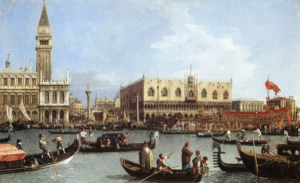
By Ivan Vrhovac, King’s College London Alumn
Early Establishment of Trade
In the lagoon on the northwest of the Adriatic Sea lies a small city that was able to become one of the most long-lasting and influential states in history. The Republic of Venice, also colloquially called la ‘Serenissima’ (the most serene), has its roots tracing back to the 6th century when small communities of Lombards started populating the islands in the lagoon where fishermen and salt workers had lived. But how was this small state able to influence most European and world affairs for close to a millennia?
The answer is trade. Its earliest traded good was salt, as the commodity allowed for longer preservation of food, and the mineral was abundantly present in the lagoon. This quickly allowed it to establish a monopoly on the salt trade connecting West and East, the Franks with the Byzantine Empire at the time. Another important early natural resource was fish. However, with time and steady income streams, a new industry was nascent: shipbuilding, which rapidly became the largest employer in the city-state, helping build both internal ship fleets and export construction to other states.
Indeed, Venetian trade required well-constructed vessels both for transport and protection against pirates and rivals. Along with its naturally favored geographic position assuring protection, the Republic was able to rapidly expand commercially and territorially in the span of a few centuries.
East Trade Routes
The Republic of Venice gradually seized a number of territories on the eastern shores of the Adriatic before 1200, mostly for commercial reasons, as pirates commonly found in the area represented a menace to trade.
Venice started trading extensively with the Byzantine Empire and had trade privileges, including a reduction in the fees for passing the Bosphorus. Exclusive trade agreements for spice and silk commerce from India through the Arab lands were developed through diplomacy, allowing it to become Europe’s main importer of Asian goods, an important rarity. The republic also developed trading relationships with the Holy Land, Alexandria, and Islamic states, defying the Pope’s desired embargo of trade between Christians and Muslims.
By the late 13th century, Venice was the most prosperous city in all of Europe. At the peak of its power, it had 36,000 sailors operating 3,300 ships, dominating Mediterranean commerce. Venice’s leading families competed to build splendid palaces and to support the work of the most talented artists. Venetian merchants also developed commercial innovations such as limited partnerships as well as complex banking and accounting systems. They invented the patent in 1474 to protect their intellectual property, a modern mechanism at the time fostering commerce.

Map of Venice (Source: Deviant Art)
Renaissance
The newly invented German printing press spread rapidly throughout Europe in the 15th century, and Venice was quick to adopt it. By 1482, Venice was the printing capital of the world, inventing paperback books that could be carried in a saddlebag.
Architecture was a source through which the power and grandiosity of the Republic were displayed. Venetian Gothic is a particular style of architecture that was prominent in many buildings designed in the 15th century, taking inspiration from Byzantine shapes, including most buildings on St. Mark’s Square.

Biblioteca Marciana (Source: Mus3ums)
As the economy grew, aristocratic and merchant families throughout the Republic became wealthier. This also led to artistic and cultural patronage movements within the city. The painters of the Venetian Renaissance sought to blend classical painting with new forms and techniques. They used more color palettes (imported from Asia) and focused heavily on detail and embellishment. This captured the hedonism of the time, with society relishing in its newfound riches as works reflected the prevailing joy and decadence.
Long ties with Byzantium had left a lasting preference for mosaics and iconlike images, but by the 1470s,, Venetian painters had absorbed the Renaissance innovations of Florence and central Italy. In the works of painters Bellini, Titian, and Tintoretto, its full potential was realized, which would characterize Venetian painting for centuries to come.

Miracle of the Slave (Tintoretto, 16th century)
Decline
Venice’s long decline started in the 15th century. Venice confronted the Ottoman Empire and sent ships to help defend Constantinople against the Turks in 1453. After the Fall of Constantinople, the Turks declared a series of Ottoman-Venetian wars that cost Venice much of its eastern Mediterranean possessions. Vasco da Gama‘s 1497–1499 voyage opened a sea route to India around the Cape of Good Hope and destroyed Venice’s monopoly on trade, giving way to the rise of the Portuguese & Spanish empires.
Venetian policy in the 16th century was dictated by the need to keep intact its political, economic, and territorial heritage against the advance of the Turks on the one side and the pressure of the great Western European powers on the other. Venetian peace and neutrality meant a new spirit of conservatism grew increasingly prominent. This led to falling influence and oligarchy rule in the 17th and 18th centuries.
The end of the republic came after the outbreak of the French Revolution. Napoleon claimed a pretext that Venice was a menace during his Austrian campaign, putting an end to the 11th century of Venetian independence.
 The Basin of St. Mark (Canaletto, 18th century)
The Basin of St. Mark (Canaletto, 18th century)

Ivan Vrhovac
Ivan is a King’s College London graduate from Croatia. He is interested in the public markets, macroeconomic developments, and new industry trends. He enjoys meeting curious people and learning about different cultures.